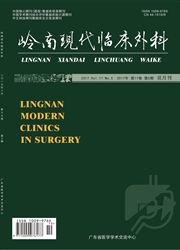

 中文摘要:
中文摘要:
This case report describes a foreign body retained in the liver long after perihepatic gauze packing. A 64-year-old female patient had suffered a rib fracture and liver rupture during a traffic accident in 1973. She discovered a mass in her right hypochondrium. Her hepatic ultrasonography showed a round mass (20.3 cm × 17.3 cm × 16.0 cm in size) with fluid echogenicity in the right lobe of her liver, and a hepatic cystic-solid mass (19.7 cm × 18.5 cm × 15.6 cm in size) was identified in an abdominal computerized tomography scan. Several pieces of gauze were extracted, and brown pus from the hepatic mass was suctioned during her exploratory laparotomy. Histology documented gauze remnants with necrotic material inclusions and fibrotic capsules. To our knowledge, this patient’s case represents the longest time for which a foreign body has been retained in the liver. In addition, we conducted a comprehensive literature review of foreign bodies retained in the liver. Foreign bodies may be introduced into the liver via penetrating trauma, surgical procedures or the ingestion of foreign bodies (which then migrate from the gut). Thus, they can be classified into the following three categories: penetrating, medical and migrated foreign bodies. The details of the case are thoroughly described.
 英文摘要:
英文摘要:
This case report describes a foreign body retained in the liver long after perihepatic gauze packing. A 64-year-old female patient had suffered a rib fracture and liver rupture during a traffic accident in 1973. She discovered a mass in her right hypochondrium. Her hepatic ultrasonography showed a round mass (20.3 cm × 17.3 cm × 16.0 cm in size) with fluid echogenicity in the right lobe of her liver, and a hepatic cystic-solid mass (19.7 cm × 18.5 cm × 15.6 cm in size) was identified in an abdominal computerized tomography scan. Several pieces of gauze were extracted, and brown pus from the hepatic mass was suctioned during her exploratory laparotomy. Histology documented gauze remnants with necrotic material inclusions and fibrotic capsules. To our knowledge, this patient’s case represents the longest time for which a foreign body has been retained in the liver. In addition, we conducted a comprehensive literature review of foreign bodies retained in the liver. Foreign bodies may be introduced into the liver via penetrating trauma, surgical procedures or the ingestion of foreign bodies (which then migrate from the gut). Thus, they can be classified into the following three categories: penetrating, medical and migrated foreign bodies. The details of the case are thoroughly described.
 同期刊论文项目
同期刊论文项目
 同项目期刊论文
同项目期刊论文
 Functional distinction of rat liver natural killer cells from spleen natural killer cells under norm
Functional distinction of rat liver natural killer cells from spleen natural killer cells under norm 期刊信息
期刊信息
